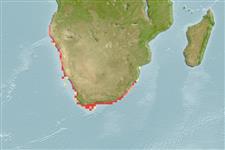Environment: milieu / climate zone / depth range / distribution range
Οικολογία
Θαλασσινό(ά); Γλυκού νερού; Υφάλμυρο βενθικό(ς); κατάδρομος (Ref. 46888). Subtropical; 16°S - 36°S
Southeast Atlantic: South African coastal waters from Walfish Bay to Natal.
Length at first maturity / Μέγεθος / Βάρος / Age
Maturity: Lm 25.0 range ? - ? cm
Max length : 40.5 cm TL αρσενικό/απροσδιόριστο; (Ref. 3573); common length : 30.0 cm TL αρσενικό/απροσδιόριστο; (Ref. 2830)
Ραχιαίες άκανθες (συνολικά) : 5; Μαλακές ραχιαίες ακτίνες (συνολικά) : 8 - 9; Εδρικές άκανθες: 3; Μαλακές εδρικές ακτίνες: 9.
Found in coastal waters, mainly off rocky points and sandy beaches; may enter estuaries which serve as nursery areas (Ref. 27121). Feed mainly on diatoms and detritus, but also on planktonic crustaceans (Ref. 27121). Oviparous, eggs are pelagic and non-adhesive (Ref. 205). A primary target species of the inshore net fishery and much of it is sold salted and dried and known as 'bokkoms'. It is also an important exhibit species in public aquaria in South Africa. It is parasitised by the monogenean Gyrodactylus molweni on the external body surface (Ref. 124050).
Life cycle and mating behavior
Maturities | Αναπαραγωγή | Spawnings | Egg(s) | Fecundities | Προνύμφες
Smith, M.M. and J.L.B. Smith, 1986. Mugilidae. p. 714-720. In M.M. Smith and P.C. Heemstra (eds.) Smiths' sea fishes. Springer-Verlag, Berlin. (Ref. 4393)
IUCN Red List Status (Ref. 130435)
Threat to humans
Harmless
Human uses
αλιεία: Εμπορικό(ά); Ενυδρείο: Δημόσια ενυδρεία
Εργαλεία
Special reports
Download XML
Διαδικτυακές πηγές
Estimates based on models
Preferred temperature (Ref.
123201): 14.8 - 27, mean 24.8 °C (based on 56 cells).
Phylogenetic diversity index (Ref.
82804): PD
50 = 0.5005 [Uniqueness, from 0.5 = low to 2.0 = high].
Bayesian length-weight: a=0.01096 (0.00602 - 0.01998), b=2.95 (2.80 - 3.10), in cm total length, based on LWR estimates for this species & Genus-body shape (Ref.
93245).
Τροφικό Επίπεδο (Ref.
69278): 2.4 ±0.16 se; based on food items.
Ελαστικότητα (Ref.
120179): Μεσαίο(α), ελάχιστος χρόνος για διπλασιασμό πληθυσμού 1,4 - 4,4 έτη (Preliminary K or Fecundity.).
Fishing Vulnerability (Ref.
59153): Low to moderate vulnerability (31 of 100).
Nutrients (Ref.
124155): Calcium = 53.2 [14.2, 311.9] mg/100g; Iron = 0.741 [0.382, 1.308] mg/100g; Protein = 18.2 [16.8, 19.7] %; Omega3 = 0.681 [0.307, 1.551] g/100g; Selenium = 7.2 [3.0, 17.9] μg/100g; VitaminA = 11.3 [3.4, 37.6] μg/100g; Zinc = 0.691 [0.433, 1.097] mg/100g (wet weight);
